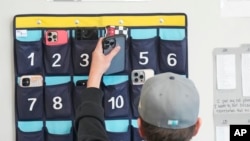Student Union
Iowa’s Clark Becomes NCAA Division-I All-Time Leading Scorer for Men’s and Women’s Basketball

Iowa star Caitlin Clark became the all-time NCAA Division I scoring leader on Sunday, breaking the late Pete Maravich's 54-year-old record when she made two free throws after a technical foul was called in the No. 6 Hawkeyes' game against No. 2 Ohio State.
Clark entered the game in Iowa City needing 18 points to pass Maravich's total of 3,667, amassed in just 83 games over three seasons at LSU (1967-70).
Maravich's record fell four days after Clark broke Lynette Woodard's major college women's record with 33 points against Minnesota on Wednesday.
Clark's record-setting points Sunday came in improbable fashion. Best-known for her long 3-point shots, she instead went past Maravich after Ohio State was called for a technical foul with less than a second to go in the first half.
Clark swished both free throws to run her career total to 3,668 points; she had no immediate reaction after the second shot went through, as if it hadn't sunk in yet.
Asked in a television interview at halftime if she was aware of the record when she stepped to the line, Clark said, "Not really. When they announced it and everybody screamed, that's when I knew."
Clark got off to a slow start. Her first shot was a 3-pointer that bounced off the rim. She missed a layup and from deep on the right wing before making a 3 from the left side for her first basket.
After starting 2 for 7, she made 3 of her next 4 shots — including three straight 3-pointers, each deeper than the previous.
Woodard was among the attendees at Carver-Hawkeye Arena to help Clark celebrate senior day. Also on hand were basketball great Maya Moore, who was Clark's favorite player, and Baseball Hall of Fame pitcher Nolan Ryan.
On Thursday, Clark announced she would enter the 2024 WNBA draft and skip the fifth year of eligibility available to athletes who competed during the COVID-19 pandemic. She is projected to be the No. 1 overall pick by the Indiana Fever, and the WNBA already is seeing a rise in ticket sales.
Logitix, which researches prices on ticket resale platforms, reported an average sale price of $598 for a ticket to this game purchased since Feb. 1.
"Listen, this is the greatest ticket on the planet right now," Woodard said in an interview with ESPN before the game. "Hey, I'm going to enjoy this right now."
Clark is all but assured of one or two more appearances at the arena in Iowa City after Sunday. Iowa is projected to be a No. 2 seed for the NCAA Tournament, meaning it would be at home for the first two rounds.
Pearl Moore of Francis Marion owns the overall women's record with 4,061 points from 1975-79 at the small-college level in the AIAW. Moore had 177 points at Anderson Junior College before enrolling at Francis Marion.
Clark was 393 behind Moore as of halftime Sunday, and she has only three to 10 more games left in an Iowa uniform depending on how far the Hawkeyes advance in the Big Ten and NCAA tournaments.
The fall of Maravich's record will be subject to scrutiny.
Maravich's all-time scoring mark is one of the more remarkable in sports history. There was no shot clock or 3-point line in his era. The 3-point line was adopted in 1986.
Maravich averaged 44.2 points per game. He scored more than 60 in a game four times, topping out at 69 against Alabama on Feb. 7, 1970.
Clark averages 28.3 points for her career and was playing in her 130th game Sunday. Her career-best output was 49 points against Michigan on Feb. 15, when she passed Kelsey Plum as the NCAA women's Division I career scoring leader.
Clark has 54 games with at least 30 points, the most of any player in men's or women's college basketball over the last 25 years. She has six triple-doubles this season and 17 in her career.
"What Caitlin's done has been amazing. She's a fantastic player, great for the women's game and basketball in general," Maravich's eldest son, Jaeson, told The Associated Press last week.
- By VOA News
Number of US Doctoral Degrees at All-Time High
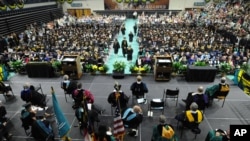
The number of doctoral degrees awarded by colleges and universities in the United States is at an all-time high, following a drop during the pandemic.
Forbes reports the jump between 2021 and 2022 was the largest one-year increase recorded since 1970. (February 2024)
- By Senanu Tord
US Embassy in Ghana Expands Outreach, Invites More Ghanaians to Study in America
In the past academic year, U.S. colleges and universities saw a nearly 32 percent increase in Ghanaian students, making Ghana one of the top 25 countries in the world for sending students to the United States. To accommodate the growing interest, the U.S. Embassy in Ghana has opened a new resource center for young people considering an American education. Senanu Tord reports from Kumasi, Ghana.
- By VOA News
How Are Colleges Using Generative AI?

Professors are using tools such as ChatGPT to provide feedback, grade assignments, prepare slide decks and more.
Ashley Mowreader reports on a Tyton Partners survey for Inside Higher Ed. (February 2023)
US Schools Wrestle with Cellphones in Classrooms
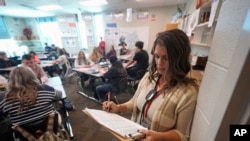
In California, a high school teacher complains that students watch Netflix on their phones during class. In Maryland, a chemistry teacher says students use gambling apps to place bets during the school day.
Around the country, educators say students routinely send Snapchat messages in class, listen to music and shop online, among countless other examples of how smartphones distract from teaching and learning.
The hold that phones have on adolescents in America today is well-documented, but teachers say parents are often not aware to what extent students use them inside the classroom. And increasingly, educators and experts are speaking with one voice on the question of how to handle it: Ban phones during classes.
"Students used to have an understanding that you aren't supposed to be on your phone in class. Those days are gone," said James Granger, who requires students in his science classes at a Los Angeles-area high school to place their phones in "a cellphone cubby" with numbered slots. "The only solution that works is to physically remove the cellphone from the student."
Most schools already have rules regulating student phone use, but they are enforced sporadically. A growing number of leaders at the state and federal levels have begun endorsing school cellphone bans and suggesting new ways to curb access to the devices.
The latest state intervention came in Utah, where Gov. Spencer Cox, a Republican, last month urged all school districts and the state Board of Education to remove cellphones from classrooms. He cited studies that show learning improves, distractions are decreased and students are more likely to talk to each other if phones are taken away.
"We just need a space for six or seven hours a day where kids are not tethered to these devices," Cox told reporters this month. He said his initiative, which is not binding, is part of a legislative push to protect kids in Utah from the harms of social media.
Last year, Florida became the first state to crack down on phones in school. A law that took effect in July requires all Florida public schools to ban student cellphone use during class time and block access to social media on district Wi-Fi. Some districts, including Orange County Public Schools, went further and banned phones the entire school day.
Oklahoma, Vermont and Kansas have also recently introduced what is becoming known as "phone-free schools" legislation.
And two U.S. senators — Tom Cotton, an Arkansas Republican, and Tim Kaine, a Virginia Democrat — introduced legislation in December that would require a federal study on the effects of cellphone use in schools on students' mental health and academic performance. Theirs is one of several bipartisan alliances calling for stiffer rules for social media companies and greater online safety for kids.
Nationally, 77% of U.S. schools say they prohibit cellphones at school for non-academic use, according to the National Center for Education Statistics.
But that number is misleading. It does not mean students are following those bans or all those schools are enforcing them.
Just ask teachers.
"Cellphone use is out of control. By that, I mean that I cannot control it, even in my own classroom," said Patrick Truman, who teaches at a Maryland high school that forbids student use of cellphones during class. It is up to each teacher to enforce the policy, so Truman bought a 36-slot caddy for storing student phones. Still, every day, students hide phones in their laps or under books as they play video games and check social media.
Tired of being the phone police, he has come to a reluctant conclusion: "Students who are on their phones are at least quiet. They are not a behavior issue."
A study last year from Common Sense Media found that 97% of kids use their phones during school hours, and that kids say school cellphone policies vary — often from one classroom to another — and aren't always enforced.
For a school cellphone ban to work, educators and experts say the school administration must be the one to enforce it and not leave that task to teachers. The Phone-Free Schools Movement, an advocacy group formed last year by concerned mothers, says policies that allow students to keep phones in their backpacks, as many schools do, are ineffective.
"If the bookbag is on the floor next to them, it's buzzing and distracting, and they have the temptation to want to check it," said Kim Whitman, a co-founder of the group, which advises schools to require phones be turned off and locked away all day.
Some students say such policies take away their autonomy and cut off their main mode of communication with family and friends. Pushback also has come from parents who fear being cut off from their kids if there is a school emergency. Whitman advises schools to make exceptions for students with special educational and medical needs, and to inform parents on expert guidance that phones can be a dangerous distraction for students during an emergency.
Jaden Willoughey, 14, shares the concern about being out of contact with his parents if there's a crisis. But he also sees the upsides of turning in his phone at school.
At Delta High School in rural Utah, where Jaden is a freshman, students are required to check their phones at the door when entering every class. Each of the school's 30 or so classrooms has a cellphone storage unit that looks like an over-the-door shoe bag with three dozen smartphone-sized slots.
"It helps you focus on your work, and it's easier to pay attention in class," Jaden said.
A classmate, Mackenzie Stanworth, 14, said it would be hard to ignore her phone if it was within reach. It's a relief, she said, to "take a break from the screen and the social life on your phone and actually talk to people in person."
It took a few years to tweak the cellphone policy and find a system that worked, said Jared Christensen, the school's vice principal.
"At first it was a battle. But it has been so worth it," he said. "Students are more attentive and engaged during class time. Teachers are able to teach without competing with cellphones. And student learning has increased," he said, citing test scores that are at or above state averages for the first time in years. "I can't definitively say it's because of this policy. But I know it's helping."
The next battle will be against earbuds and smartwatches, he said. Even with phones stashed in pouches, students get caught listening to music on air pods hidden under their hair or hoodies. "We haven't included earbuds in our policy yet. But we're almost there."
- By VOA News
Governments Should Recognize the Economic Benefits of International

Several English-speaking countries, including Canada and the U.K., have recently moved to limit international student numbers.
While the potential downsides of student immigration are often reported on, Alan Beattie of The Financial Times argues the upsides aren’t stressed enough. (February 2023)
- By VOA News
FAFSA Delays Are Worrying Students and Educators
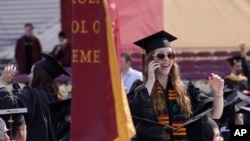
FAFSA, the federal form used to apply for financial aid, was revamped this year. But the new version has been delayed – and so that could mean a delay in financial aid for many students.
Sarah Wood reports for US News & World Report. (February 2024)
- By VOA News
International Student Enrollment in US Surged 13% Last Year

That’s according to 2022-2023 academic year data from Open Doors.
Read more about the surge, including which countries are sending the most students to the U.S., in this summary from Viggo Stacey of The PIE News. (February 2024)
- By VOA News
US Campuses Face ‘Transnational Repression’
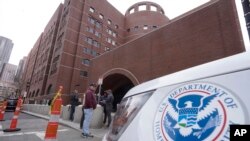
A new report from Freedom House explains how authoritarian governments try to police and harass students on U.S. campuses.
Read a summary in Karin Fischer’s newsletter for the Chronicle of Higher Education. (January 2024)
- By VOA News
How Does Medical School Work?
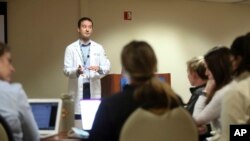
A medical education in the U.S. is long and frequently expensive. But with high average earnings, and the opportunity to save lives, many think it’s worth it.
Sarah Wood explains the basics of medical education for the US News & World Report. (January 2024)
Biden Cancels Federal Student Loans for Nearly 153,000 Borrowers
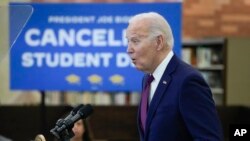
President Joe Biden said Wednesday that while a college degree was still a ticket to a better life, that ticket is often too expensive, as he announced he was canceling federal student loans for nearly 153,000 borrowers.
Biden, who is in the midst of a three-day campaign swing through California, made the announcement as part of a new repayment plan that offers a faster path to forgiveness, putting the spotlight on his debt cancellation efforts in his reelection campaign.
"Too many Americans are still saddled with unsustainable debt in exchange for a college degree," he said from a local library before he went on to campaign-related events. Loan relief helps the greater economy, he said, because "when people have a student debt relief, they buy homes. They start businesses, they contribute. They engage."
The administration began sending email notifications on Wednesday to some of the borrowers who will benefit from what the White House has called the SAVE program. The cancellations were originally scheduled to start in July, but last month the administration said it would be ready almost six months ahead of schedule, in February.
"Starting today, the first round of folks who are enrolled in our SAVE student loan repayment plan who have paid their loans for 10 years and borrowed $12,000 or less will have their debt cancelled," Biden posted on social media Wednesday. "That's 150,000 Americans and counting. And we're pushing to relieve more."
The first round of forgiveness from the SAVE plan will clear $1.2 billion in loans. The borrowers will get emails with a message from Biden notifying them that "all or a portion of your federal student loans will be forgiven because you qualify for early loan forgiveness under my Administration's SAVE Plan."
In his email to borrowers, Biden wrote he had heard from "countless people who have told me that relieving the burden of their student loan debt will allow them to support themselves and their families, buy their first home, start a small business, and move forward with life plans they've put on hold."
More than 7.5 million people have enrolled in the new repayment plan.
He said Wednesday that it was the kind of relief "that can be life-changing for individuals and their families."
"I'm proud to have been able to give borrowers like so many of you the relief you earned," he said, asking the crowd gathered for his speech how many had debt forgiven. Many raised their hands.
Borrowers are eligible for cancellation if they are enrolled in the SAVE plan, originally borrowed $12,000 or less to attend college and have made at least 10 years of payments. Those who took out more than $12,000 will be eligible for cancellation but on a longer timeline. For each $1,000 borrowed beyond $12,000, it adds an additional year of payments on top of 10 years.
The maximum repayment period is capped at 20 years for those with only undergraduate loans and 25 years for those with any graduate school loans.
Biden announced the new repayment plan last year alongside a separate plan to cancel up to $20,000 in loans for millions of Americans. The Supreme Court struck down his plan for widespread forgiveness, but the repayment plan has so far escaped that level of legal scrutiny. Unlike his proposal for mass cancellation — which had never been done before — the repayment plan is a twist on existing income-based plans created by Congress more than a decade ago.
Biden said he remained steadfast in his commitment to "fix our broken student loan system," working around the court's ruling to find other ways to get it done.
- By VOA News
Academic Superstars Are Facing Accusations of Plagiarism
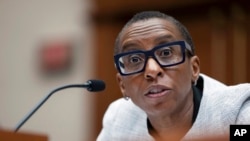
Harvard’s former president Claudine Gay resigned recently after being accused of plagiarism. Now, the work of top researchers in many fields is facing scrutiny. Anemona Hartocollis reports for The New York Times. (January 2024).
- By VOA News
This College Student’s Acceptance Letter Came With a Marching Band
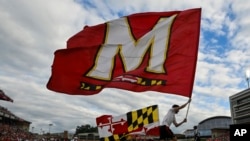
Alejandro Marroquin, 17, was surprised one morning by a full marching band outside his home, carrying a letter admitting him to the University of Maryland. Read the story from Emily Davies of The Washington Post. (January 2024)
- By VOA News
Biden’s Student-Loan Repayment Program Is Starting Up

The new program could save many borrowers at least $1,000 per year. Danielle Douglas-Gabriel has the details in The Washington Post. (January 2024)
- By VOA News
Biden Administration Forgiving Some Student Debt Early
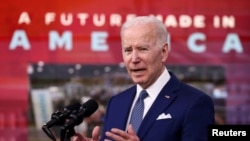
One of President Joe Biden’s campaign promises was to help Americans with student loans.
Now, the Biden administration plans to forgive debt for those who borrowed less than $12,000 and have been paying their debt for a decade or more. The news comes six months before a self-imposed deadline to launch the initiative.
Danielle Douglas-Gabriel has more in The Washington Post. (January 2024)






